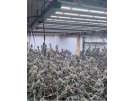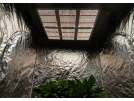What Is The LED Grow Light?
Time: 2023-12-28
LED (Light Emitting Diode) grow lights are a modern and energy-efficient way of providing light to indoor plants. These lights have been gaining popularity over traditional lighting systems due to their low energy consumption, extended lifespan, and improved spectral output that closely resembles natural sunlight. The purpose of this paper is to explore LED grow lights, their advantages, and disadvantages, and how they compare to other types of grow lights.
Advantages of LED Grow Lights
1)Energy Efficiency - LED grow lights are highly energy-efficient, consuming up to 70% less electricity than traditional lighting systems. This not only saves money on electricity bills but also helps reduce the overall carbon footprint.
2)Extended Lifespan - LED grow lights have a much longer lifespan than traditional lighting systems, lasting up to 50,000 hours or more. This means less maintenance and replacement costs for growers.
3)Spectrum Control - LED grow lights allow growers to customize the light spectrum according to their plant's needs, providing an optimal environment for growth and development.Heat Output - LED grow lights produce less heat than traditional lighting systems, reducing the need for additional cooling systems and preventing damage to plants.
4)Space Efficiency - LED grow lights are compact and can be installed in small spaces, making them ideal for indoor gardening.
Disadvantage of LED Grow Lights
3)Quality Control - The quality of LED grow lights can vary widely, making it essential to research and choose a reputable brand to avoid wasting money on low-quality products.
1)HID (High-Intensity Discharge) Lights - HID lights are known for their high output and intensity, making them popular for commercial growers. However, they consume a lot of energy and produce a lot of heat, making them less energy-efficient and requiring additional cooling systems. HID lights also have a limited lifespan and need to be replaced frequently.
2)Fluorescent Lights - Fluorescent lights are an affordable and energy-efficient option for indoor gardening. However, they have a limited spectrum, making them less effective for growing plants that require specific wavelengths.
3)HPS (High-Pressure Sodium) Lights - HPS lights are commonly used for indoor gardening and produce a high output of yellow and red light. However, they consume a lot of energy and produce a lot of heat, making them less efficient than LED grow lights. HPS lights also have a limited lifespan and need to be replaced frequently.
Conclusion
In conclusion, LED grow lights offer a range of benefits for indoor gardening, including energy efficiency, extended lifespan, spectrum control, and space efficiency. While they can be expensive, the long-term cost savings and benefits outweigh the initial investment. LED grow lights also have several advantages over traditional lighting systems such as HID and HPS lights, including lower energy consumption and heat output. As technology continues to improve, LED grow lights will become an even more viable option for indoor gardening.
News
-

How To Choose LED Grow Light?
There are several factors you should conside...
-

What Is The LED Grow Light?
LED (Light Emitting Diode) grow lights are ...
-

From Seedlings to Success: Buyer's Guide to LED Grow Lights
Welcome, aspiring horticulturalists and indoor...
-

What Kind of LED Grow Lights Do Professional Growers Use?
Professional growers use a variety of LED g...
Contact Us
Email:season@led-slt.com
